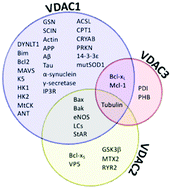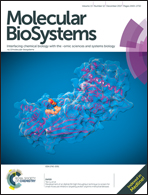Protein–protein interaction networks as a new perspective to evaluate distinct functional roles of voltage-dependent anion channel isoforms
Abstract
Voltage-dependent anion channels (VDACs) are a family of three mitochondrial porins and the most abundant integral membrane proteins of the mitochondrial outer membrane (MOM). VDACs are known to be involved in metabolite/ion transport across the MOM and in many cellular processes ranging from mitochondria-mediated apoptosis to the control of energy metabolism, by interacting with cytosolic, mitochondrial and cytoskeletal proteins and other membrane channels. Despite redundancy and compensatory mechanisms among VDAC isoforms, they display not only different channel properties and protein expression levels, but also distinct protein partners. Here, we review the known protein interactions for each VDAC isoform in order to shed light on their peculiar roles in physiological and pathological conditions. As proteins associated with the MOM, VDAC opening/closure as a metabolic checkpoint is regulated by protein–protein interactions, and is of pharmacological interest in pathological conditions such as cancer. The interactions involving VDAC1 have been characterized more in depth than those involving VDAC2 and VDAC3. Nevertheless, the so far explored VDAC–protein interactions for each isoform show that VDAC1 is mainly involved in the maintenance of cellular homeostasis and in pro-apoptotic processes, whereas VDAC2 displays an anti-apoptotic role. Despite there being limited information on VDAC3, this isoform could contribute to mitochondrial protein quality control and act as a marker of oxidative status. In pathological conditions, namely neurodegenerative and cardiovascular diseases, both VDAC1 and VDAC2 establish abnormal interactions aimed to counteract the mitochondrial dysfunction which contributes to end-organ damage.



 Please wait while we load your content...
Please wait while we load your content...